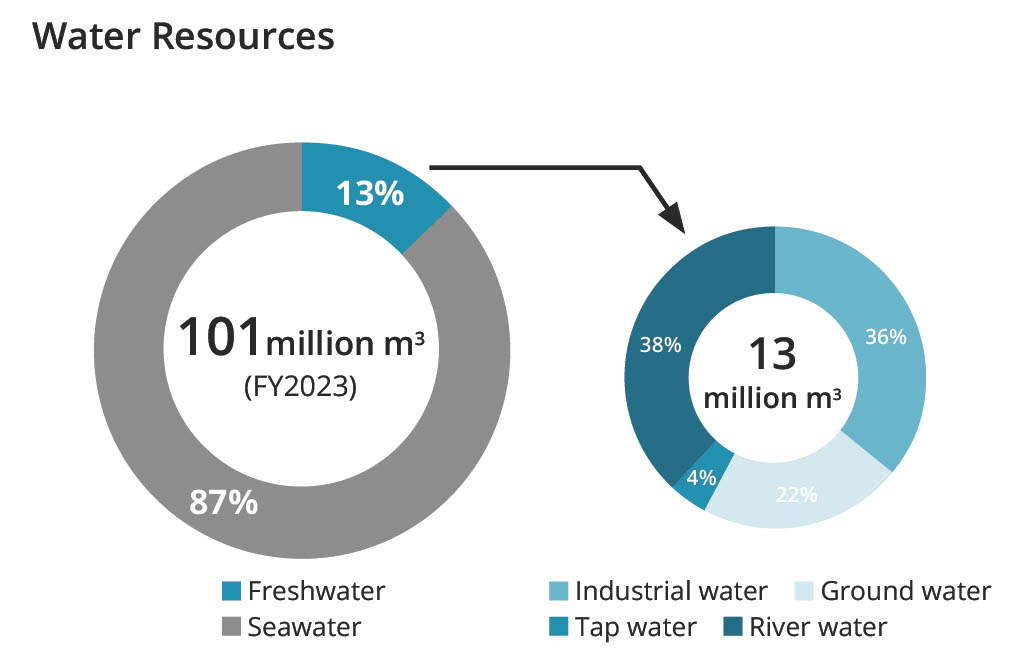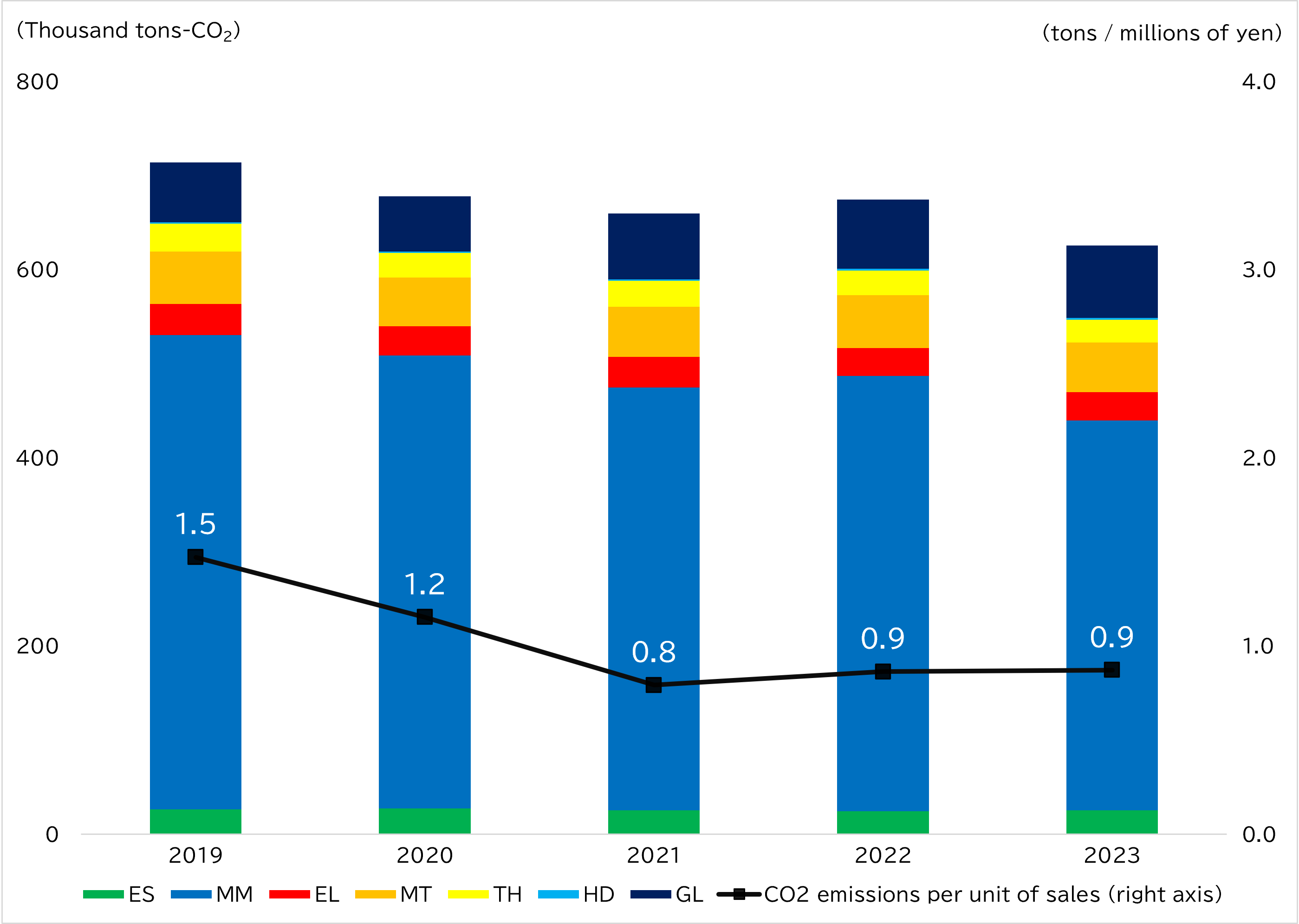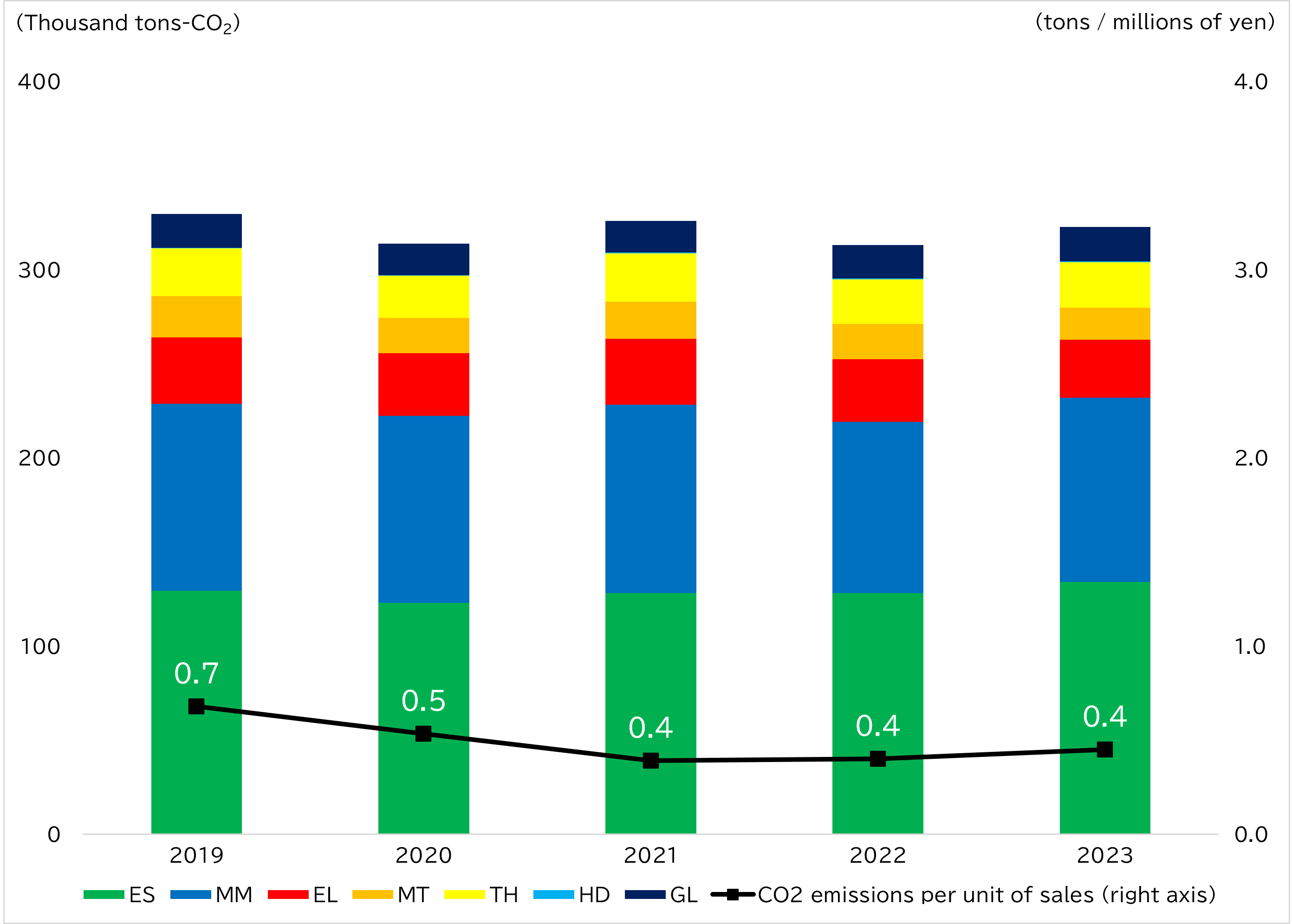The scope of environmental data reporting covers a total of 61 companies, including the Company and its consolidated subsidiaries. For details, please refer to the following link.
-
 Subsidiaries and affiliates
(69KB)
Subsidiaries and affiliates
(69KB)
Approximately 80% of the Group’s major production bases have established an environmental management system (EMS) structure for environmental management.
(Unit : Locations)
|
Certification |
Domestic |
Overseas |
|
ISO 14001 |
30 |
15 |
|
Eco-Action 21 |
9 |
0 |
|
Green Management Certification |
2 |
0 |
|
Total |
56 |
|
|
Unit |
FY2019 |
FY2020 |
FY2021 |
FY2022 |
FY2023 |
|||
|
INPUT |
Total energy input |
PJ |
18 |
17 |
18 |
17.5 |
17.4 |
|
|
Fossil fuel consumption |
Thousand kL |
121 |
113 |
115 |
108 |
115 |
||
|
Biomass fuel consumption |
MJ |
- |
- |
- |
- |
1 |
||
|
Purchased electric power |
GWh |
1,352 |
1,305 |
1,358 |
1,333 |
1,270 |
||
|
Thermal power generation |
GWh |
5 |
1 |
1.4 |
1.0 |
1.1 |
||
|
Biomass power generation |
MWh |
– |
– |
902 |
181 |
241 |
||
|
Hydroelectric power generation |
GWh |
39 |
48 |
73 |
69 |
62 |
||
|
Solar power generation |
MWh |
335 |
388 |
1,564 |
1,881 |
2,675 |
||
|
Purchased steam flow |
GJ |
388 |
300 |
98 |
0 |
0 |
||
|
Water resources |
Million m3 |
106 |
100 |
103 |
101 |
101 |
||
|
Seawater |
Million m3 |
93 |
88 |
90 |
89 |
87 |
||
|
Besides seawater |
Million m3 |
13 |
13 |
13 |
12 |
13 |
||
|
Raw material use |
Thousand tons |
1,058 |
972 |
1,089 |
1,041 |
936 |
||
|
Raw materials |
Thousand tons |
806 |
715 |
807 |
783 |
698 |
||
|
Auxiliary materials |
Thousand tons |
162 |
179 |
192 |
173 |
146 |
||
|
Heat treatment of items received |
Thousand tons |
89 |
77 |
89 |
83 |
90 |
||
|
Packaging materials |
Thousand tons |
2 |
1 |
1.5 |
1.2 |
1.2 |
||
|
Amount of waste received |
Thousand tons |
1,556 |
1,440 |
1,590 |
1,680 |
1,675 |
||
|
Waste |
Thousand tons |
1,420 |
1,304 |
1,476 |
1,557 |
1,575 |
||
|
Statutory recycled items received |
Thousand tons |
96 |
98 |
74 |
93 |
92 |
||
|
Contaminated soil |
Thousand tons |
40 |
38 |
40 |
29 |
7 |
||
|
Fluorocarbon throughput |
tons |
552 |
604 |
779 |
917 |
954 |
||
|
Unit |
FY2019 |
FY2020 |
FY2021 |
FY2022 |
FY2023 |
||
|
Within business areas |
Waste heat power generation |
GWh |
83 |
80 |
98 |
87 |
71 |
|
Waste heat utilization |
TJ |
427 |
443 |
1,007 |
934 |
1,121 |
|
|
Unit |
FY2019 |
FY2020 |
FY2021 |
FY2022 |
FY2023 |
|||||
|
OUTPUT |
Total greenhouse gas emissions |
Thousand tons-CO2 |
1,903 |
1,815 |
1,724 |
1,713 |
1,649 |
|||
|
Electric power source |
Thousand tons-CO2 |
714 |
678 |
659 |
674 |
626 |
||||
|
Fossil fuel source |
Thousand tons-CO2 |
330 |
314 |
326 |
313 |
323 |
||||
|
Waste source |
Thousand tons-CO2 |
860 |
823 |
738 |
726 |
701 |
||||
|
Amount of electric energy sold |
GWh |
0.8 |
1.2 |
1.8 |
3.0 |
8.3 |
||||
|
Product quantity |
Thousand tons |
945 |
886 |
965 |
928 |
880 |
||||
|
Chemical substance emissions |
tons |
1,773 |
1,542 |
1,489 |
1,526 |
2,160 |
||||
|
Drainage water discharge |
Million m3 |
117 |
114 |
100 |
99 |
98 |
||||
|
Seawater |
Million m3 |
93 |
87 |
89 |
88 |
87 |
||||
|
Excluding seawater |
Million m3 |
24 |
27 |
11 |
11 |
11 |
||||
|
Recycling and waste amount |
Thousand tons |
1,001 |
1,086 |
1,040 |
1,029 |
1,124 |
||||
|
Recycled amount |
Thousand tons |
634 |
612 |
645 |
638 |
733 |
||||
|
Thermal recycling |
Thousand tons |
352 |
344 |
353 |
352 |
471 |
||||
|
inside the Group |
Thousand tons |
45 |
45 |
41 |
421 |
|||||
|
outside the Group |
Thousand tons |
299 |
309 |
311 |
50 |
|||||
|
Material recycling |
Thousand tons |
282 |
269 |
291 |
286 |
261 |
||||
|
inside the Group |
Thousand tons |
180 |
200 |
192 |
159 |
|||||
|
outside the Group |
Thousand tons |
89 |
91 |
93 |
102 |
|||||
|
Waste generated |
Thousand tons |
367 |
473 |
396 |
391 |
392 |
||||
Note:
- With regard to CO2 emissions, in principle the DOWA Group seeks to multiply amounts of electricity purchased, fossil fuel consumed, and waste received by the emission factor put forth in the Law Concerning the Promotion of Measures to Cope with Global Warming.
- Regarding CO2 emissions derived from waste received, because the calculation terms are as of the time this report was prepared, numbers may not necessarily match those reported to government agencies, which are calculated at a different time.
- Due to differences in the classification of waste in Japan and overseas and to the difficulty in setting an appropriate emission factor for waste received at overseas business sites, only the portion of CO2 emissions originating from waste from domestic business locations is given.
(Unit : Locations)
|
Management Objectives Based on Agreements with Local Governments |
Self-Imposed Strict Management Goal |
|
|
Atmosphere |
6 |
14 |
|
Water management |
6 |
19 |
(Unit:tons)
|
Item |
FY2019 |
FY2020 |
FY2021 |
FY2022 |
FY2023 |
|
HCI |
25 |
25 |
39 |
36 |
35 |
|
NOx |
449 |
439 |
480 |
530 |
595 |
|
SOx |
153 |
163 |
124 |
150 |
177 |
|
Soot and dust |
37 |
39 |
33 |
25 |
24 |
(Unit : tons)
|
Item |
FY2019 |
FY2020 |
FY2021 |
FY2022 |
FY2023 |
|
COD |
427 |
360 |
423 |
222 |
178 |
|
BOD |
70 |
66 |
50 |
52 |
69 |
In FY2023, the water input was 101 million m3, almost the same amount as in the previous year. Freshwater use amounted to 13 million m3, accounting for just over 10% of total water use, an increase of 6% on the previous year.

(Unit : Million m3)
|
Item |
FY2019 |
FY2020 |
FY2021 |
FY2022 |
FY2023 |
|
River water |
4.8 |
4.8 |
4.9 |
4.4 |
4.8 |
|
Industrial water |
4.5 |
4.6 |
4.7 |
4.7 |
4.6 |
|
Ground water |
3.0 |
2.8 |
2.8 |
2.5 |
2.8 |
|
Tap water |
0.5 |
0.4 |
0.5 |
0.5 |
0.5 |
|
Total |
12.9 |
12.7 |
12.9 |
12.1 |
12.7 |
Total drainage was 98 million m3 in FY2023, about the same amount as in FY2022.
The total Scope 1 and 2 GHG emissions for the group in FY2023 were approximately 1,649 thousand tons of CO2, a decrease of 3.7% from FY2022. By source, fossil fuel-derived approximately 20%, waste-derived approximately 43%, and electricityderived accounted for approximately 38%.
(Unit : Thousand tons-CO2)
|
Item |
FY2019 |
FY2020 |
FY2021 |
FY2022 |
FY2023 |
|
|
Scope1 |
From fossil fuels |
329.6 |
313.9 |
326.1 |
313.1 |
322.7 |
|
From waste |
859.7 |
822.9 |
738.2 |
725.9 |
701.1 |
|
|
Scope2 |
From electricity |
714.1 |
678.1 |
659.5 |
674.4 |
625.5 |
|
Total CO2 emissions |
1,903.4 |
1,814.9 |
1,723.8 |
1,713.4 |
1,649.3 |
|
(*) Coverage of 90% or higher, location-based


Note : Above figures use the following abbreviations.
HD: DOWA Holdings Co., Ltd.; ES: Environmental Management & Recycling Business; MM: Nonferrous Metals Business; EL: Electronic Materials Business; MT: Metal Processing Business; TH: Heat Treatment Business; GL: Global Business
The domestic Scope 3 CO₂ emissions of our group in FY 2023 amounted to approximately 1,340 thousand tonnes of CO₂. The breakdown by category shows that Category 1 “Purchased goods and services” accounted for 57% of the total Scope 3 emissions, while Category 4 “Upstream transportation and distribution" accounted for 23%. Our company provides products and services to various markets through a circular business model and has established a diverse supply chain for raw materials and other. As a result, it is believed that the proportion of CO₂ emissions associated with the procurement of raw materials and supplies is high. We will continue to advance the visualization of CO₂ emissions in our supply chain and work on reducing GHG emissions.
(Unit : Thousand tons-CO2)
|
Category |
Coverage |
Emissions |
|
|
1 |
Purchased goods and services |
Domestic |
766.5 |
|
2 |
Capital goods |
Consolidated total (Including overseas) |
139.3 |
|
3 |
Fuel- and energy-related activities |
Domestic |
119.1 |
|
4 |
Upstream transportation and distribution |
Domestic |
303.7 |
|
5 |
Waste generated in operations |
Domestic |
5.4 |
|
6 |
Business travel |
Domestic |
0.9 |
|
7 |
Employee commuting |
Domestic |
2.8 |
|
Total |
1,337.7 |
||
|
Scope 3 Calculation Method |
|
|
Category 1 |
Costs associated with the procurement of key raw materials and materials × Emission intensity |
|
Category 2 |
Capital investment amount × Emission intensity |
|
Category 3 |
Energy consumption × Emission intensity |
|
Category 4 |
Ton-kilometers by mode of transport (Our company and our upstream company are the shippers) × Emission intensity |
|
Category 5 |
Volume of waste disposed of outside the company × Emission intensity |
|
Category 6 |
Number of Employees × Emission intensity |
|
Category 7 |
Number of employees × Number of working days × Emission intensity (By type of workplace and city category) |
|
Category 8 to 15 |
Excluded (Category 8 : Included in Scope 1 & 2, Category 9 to 12 : Difficult to calculate due to the fact that we are in the materials industry and the diversity of product applications, Category 13 to 15:Excluded) |
|
Emission intensity |
Policy on Emissions Unit Values for Accounting of Greenhouse Gas Emissions, etc., by Organizations Throughout the Supply Chain (Ver.2.5) (*) |
(*) Published by Ministry of the Environment and Ministry of Economy, Trade and Industry (Government of Japan)
|
Unit |
FY2019 |
FY2020 |
FY2021 |
FY2022 |
FY2023 |
|
|
Hydroelectric power generation |
GWh |
38.7 |
47.9 |
45.4 |
68.8 |
61.9 |
|
Solar power generation |
MWh |
335 |
388 |
1,564 |
1,881 |
2,712 |
|
Biogas power generation |
MWh |
- |
- |
902 |
2,267 |
3,376 |
|
Waste heat power generation |
GWh |
79 |
80 |
87 |
87 |
71 |
In FY2023, raw material use amounted to 936 thousand tons, a year-on-year decrease of approximately 10%. Of this, approximately 27% was recycled raw materials.
In FY2023, the amount of waste received came to 1,675 thousand tons, which is almost the same as in the previous year. Of this, approximately 89% was waste received from outside the Group.
In FY2023, thermal recycling amounted to 471 thousand tons, a year-on-year increase of approximately 33%. Material recycling totaled 261 thousand tons, a year-on-year decrease of approximately 9%.
In FY2023, the amount of waste disposed of was 392 thousand tons, which is almost the same as in the previous year.
The volume of waste discharged includes incineration residue and other residues generated after contracted treatment in our main business of waste disposal.
(Unit : Thousand tons)
|
FY2020 |
FY2021 |
FY2022 |
FY2023 |
||
|
Domestic |
427.3 |
378.2 |
378.0 |
373.4 |
|
|
Overseas |
46.0 |
17.6 |
12.7 |
18.2 |
|
|
Total |
473.3 |
395.9 |
390.7 |
391.6 |
|
|
Slag |
85.6 |
88.5 |
90.4 |
78.9 |
|
|
Hazardous waste* |
9.1 |
10.1 |
11.6 |
17.6 |
|
*Hazardous waste…Refers to waste as defined by the laws of each country. In Japan, it refers to specially-controlled industrial waste.



